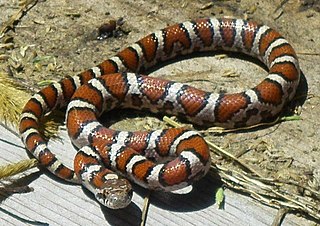The various Milksnakes are among the world’s most beautifully-colored reptiles. Most are quite hardy, easy to handle and breed, and can be kept in modestly-sized terrariums. Milksnakes are grouped with Kingsnakes in the genus Lampropeltis, which contains 16 species. Sometimes referred to as “Tri-Colored Kingsnakes”, the most popular types are considered to be subspecies of L. triangulum. Among the 26 subspecies of L. triangulum we find the gorgeous and highly-desirable Sinaloan, Pueblan, Nelson’s, Black, and Honduran Milksnakes, along with others that are a bit more difficult to keep but well-worth the consideration of experienced keepers.
The following general information can be applied to Milksnake care of both popular species and subspecies. However, details vary, especially as regards those native to higher elevations or with specific food preferences. Please post below for detailed information on the care of individual species.
Natural History
Various Milksnakes inhabit North, Central and South America. They occur in a wide range of habitats, including forest and swamp edges, prairies, rocky mountainsides, overgrown fields, desert fringes, farms and abandoned buildings.
Powerful constrictors, Milksnakes feed upon chipmunks and other rodents, shrews, moles, frogs, turtle hatchlings, lizards and a huge array of other animals. Several appear to specialize in preying upon other snakes. Some, such as the Eastern Kingsnake, have evolved immunities to the venoms of various pit vipers.
Their startling red, black, yellow and white patterns appear to mimic the warning colors of the venomous Coral Snakes that share their habitats. Mimicked Coral Snakes include Micrurus limbatus, bernadi and diastema.
By crossing various species of King and Milksnakes, and through hybridization with Corn Snakes and other species, snake enthusiasts have produced a spectacular array of unique “designer morphs”. The scope of colors and patterns exhibited, even without considering these, is stunning. Identification based on color alone is difficult, as different species and subspecies also hybridize in the wild. Most measure 2.5 – 4 feet in length, but 6.5 foot-long individuals have been recorded.
Housing
Setting up the Terrarium
Hatchlings may be raised in 5-10 gallon aquariums. A 30-55 gallon tank will accommodate an average-sized adult. The screen top should be secured with clips, as all snakes are escape artists.
Wild Milksnakes spend a good deal of time in burrows or beneath leaf litter. Caves or deep substrates into which they can burrow are essential.
Substrate
Newspapers or washable terrarium liners may be used with well-habituated snakes, but a deep substrate that allows for burrowing is preferable. Cypress mulch, aspen bedding and/or dead leaves work well, and also allow for easy “spot cleaning”.
Heat
Most Milksnakes fare best in a temperature range of 72-85 F; an incandescent spotlight should be used to create a basking spot of 85-92 F.
Large enclosures are necessary if a thermal gradient (areas of different temperatures) is to be established. Thermal gradients, critical to good health, allow snakes to regulate their body temperature by moving from hot to cooler areas.
A ceramic heater, under-tank heat pad, or red/black reptile “night bulb” can be used to provide heat after dark.
Humidity
Milksnakes are prone to fungal skin disorders (“blister disease”) when kept in damp terrariums. Water for drinking and soaking should be available, but the substrate must remain clean and dry.
Light
Milksnakes do not require a UVB light source. UVA light may be useful in encouraging natural behavior and breeding, but is not essential.
Feeding
Most adult Milksnakes readily accept pre-killed mice. Hatchlings can usually handle newborn mice, but those of smaller subspecies, such as the Eastern Milksnake, may need sectioned pinkies for a time. In the wild, youngsters feed primarily upon frogs, small lizards and, perhaps, large insects. Scenting a pinky with these foods will encourage reluctant feeders.
Companions
Many Milksnake subspecies favor other snakes as food, and are notorious cannibals. Hatchlings are especially difficult to rear in groups, but adults may also try to “sample” cage-mates, even those they have lived with for years.
Milksnakes are best kept singly, and must be carefully watched if paired for breeding (please post below for information on breeding). Individuals that are housed together should be separated at feeding time, which is when many “accidents” occur.
 That Reptile Blog – Reptile, Amphibian and Exotic Pet Care and Information
That Reptile Blog – Reptile, Amphibian and Exotic Pet Care and Information




